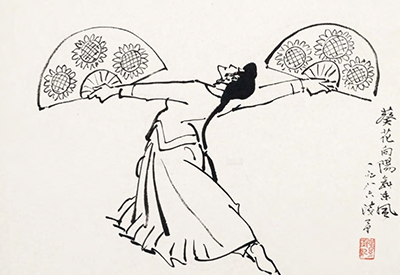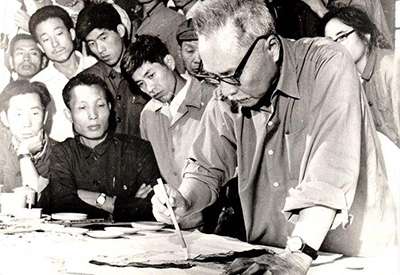Ye Qianyu
1907-1995
The form and style of Ye Qianyu’s artworks have gone through several changes in his creative process. Repeated review and examination of his own artistic experience, as well as the deepening understanding of the tradition, continue to push Ye Qianyu to take the observation and description of daily life as the starting point, and to gradually expand the aesthetic boundary of traditional art through his determination of the automaticity of painting.
Ye Qianyu’s career began in the 1920s as a cartoonist. The long-running comic book Mr. Wang, which recorded Shanghai’s walks of life, was once very popular. During the War of Resistance against Japanese Invasion, in the name of the lead of the Comic Publicity Team of the War of Resistance Association, Ye led a group of domestic cartoonists through Nanjing, Zhenjiang and Wuhan, etc., to hold comic publicity activities on the street. After he sketched from life in the Miao District in Guizhou in 1942, Ye Qianyu started to shift from comics to Chinese painting, and went to Chongqing to study Chinese painting techniques with Zhang Daqian in 1945. In the inaugural issue of People’s Art, Ye Qianyu wrote an article From Comics to Chinese Painting (self-criticism) explaining his transformation and describing his exploration in Chinese painting: “I have been working hard to bring the world we live in into Chinese painting.” The grasp of real life is the key to Ye Qianyu’s creation. The sketches Ye Qianyu had been created for life since the 1930s had provided an inexhaustible source of inspiration for his comics and Chinese paintings, and also made sketching one of the most undisputed aspects of Ye Qianyu’s artistic achievements.
Ye Qianyu was also an educator who contributed greatly to the development of art education and the inheritance of Chinese painting techniques. In 1947, Ye Qianyu was invited by Xu Beihong as an “emerging creator” (termed by Xu Beihong, meaning a representative of the New Chinese Painting) and taught at the National Art School in Beiping. After the restoration of the Chinese Painting Department in 1954, Ye Qianyu served as the head of the department, considering and exploring the artistic features and teaching methods of Chinese painting in the ever-changing political and literary environment. In 1949, National Art School in Beiping was renamed the Central Academy of Fine Arts, advocating art as a service for workers, peasants and soldiers, emphasizing creation in teaching, and paying attention to figure paintings. Ye Qianyu strived to change the system in which the techniques and creations were separated, took the lead in teaching the both to reverse the singular education system caused by the environment in which art mostly served the metaphysical slogans. By the end of the 1950s, despite the social rhetoric of “Don’t care too much of the style, just pick up the brush pen and paint”, Ye insisted on the characteristics and advantages of the national painting traditions and concentrated on studying the history and theories of painting. His viewpoints were published in his lectures at the Central Academy of Fine Arts, and papers and magazines including People’s Daily and New Observation.
Ye Qianyu created the “tradition, life, creation” trinity and the teaching system that combines “imitating, sketching, creating” out of his reflections of his own artistic experience under special social and teaching context. We can not only get a glimpse of the artistic characteristics of Ye Qianyu as an innovative figure in Chinese painting at the beginning of his teaching career, but can also see Ye Qianyu’s change of focus in the next ten years as an artist and the educator in the Central Academy of Fine Arts. The pursuit of the purity of painting and the independent reflection of the core of Chinese painting made Ye Qianyu’s creations constantly present the dynamics that is evolutionary and negative. This diversity can be seen directly in Ye Qianyu’s cartoons, Chinese paintings and sketches, as well as from his plentiful writings from different time periods.
The form and style of Ye Qianyu’s artworks have gone through several changes in his creative process. Repeated review and examination of his own artistic experience, as well as the deepening understanding of the tradition, continue to push Ye Qianyu to take the observation and description of daily life as the starting point, and to gradually expand the aesthetic boundary of traditional art through his determination of the automaticity of painting.
Ye Qianyu’s career began in the 1920s as a cartoonist. The long-running comic book Mr. Wang, which recorded Shanghai’s walks of life, was once very popular. During the War of Resistance against Japanese Invasion, in the name of the lead of the Comic Publicity Team of the War of Resistance Association, Ye led a group of domestic cartoonists through Nanjing, Zhenjiang and Wuhan, etc., to hold comic publicity activities on the street. After he sketched from life in the Miao District in Guizhou in 1942, Ye Qianyu started to shift from comics to Chinese painting, and went to Chongqing to study Chinese painting techniques with Zhang Daqian in 1945. In the inaugural issue of People’s Art, Ye Qianyu wrote an article From Comics to Chinese Painting (self-criticism) explaining his transformation and describing his exploration in Chinese painting: “I have been working hard to bring the world we live in into Chinese painting.” The grasp of real life is the key to Ye Qianyu’s creation. The sketches Ye Qianyu had been created for life since the 1930s had provided an inexhaustible source of inspiration for his comics and Chinese paintings, and also made sketching one of the most undisputed aspects of Ye Qianyu’s artistic achievements.
Ye Qianyu was also an educator who contributed greatly to the development of art education and the inheritance of Chinese painting techniques. In 1947, Ye Qianyu was invited by Xu Beihong as an “emerging creator” (termed by Xu Beihong, meaning a representative of the New Chinese Painting) and taught at the National Art School in Beiping. After the restoration of the Chinese Painting Department in 1954, Ye Qianyu served as the head of the department, considering and exploring the artistic features and teaching methods of Chinese painting in the ever-changing political and literary environment. In 1949, National Art School in Beiping was renamed the Central Academy of Fine Arts, advocating art as a service for workers, peasants and soldiers, emphasizing creation in teaching, and paying attention to figure paintings. Ye Qianyu strived to change the system in which the techniques and creations were separated, took the lead in teaching the both to reverse the singular education system caused by the environment in which art mostly served the metaphysical slogans. By the end of the 1950s, despite the social rhetoric of “Don’t care too much of the style, just pick up the brush pen and paint”, Ye insisted on the characteristics and advantages of the national painting traditions and concentrated on studying the history and theories of painting. His viewpoints were published in his lectures at the Central Academy of Fine Arts, and papers and magazines including People’s Daily and New Observation.
Ye Qianyu created the “tradition, life, creation” trinity and the teaching system that combines “imitating, sketching, creating” out of his reflections of his own artistic experience under special social and teaching context. We can not only get a glimpse of the artistic characteristics of Ye Qianyu as an innovative figure in Chinese painting at the beginning of his teaching career, but can also see Ye Qianyu’s change of focus in the next ten years as an artist and the educator in the Central Academy of Fine Arts. The pursuit of the purity of painting and the independent reflection of the core of Chinese painting made Ye Qianyu’s creations constantly present the dynamics that is evolutionary and negative. This diversity can be seen directly in Ye Qianyu’s cartoons, Chinese paintings and sketches, as well as from his plentiful writings from different time periods.
Related essays
-

-
徐悲鸿:叶浅予之国画
2019-10-12
浅予之国画一如其速写人物,同样熟练,故彼予曲直两形体,均无困难,择善择要,捕捉撷取,毫不避忌,此在国画上如此高手,五百年来,仅有仇十洲、吴友如两人而已,故浅予在艺术上之成就,诚非同小可也。More
-

-
留住生命:叶浅予速写谈片
2019-10-12
叶浅予先生一生总共画了多少幅速写,可能是一个艺术史之谜。粗略的估算,应该不少于25000幅。所以,到目前为止的各种已出版的叶浅予速写集加在一起,相对于他所画的全部速写,也只如巨大冰山浮出海面的一角。More
-

-
The Central Academy of Fine Arts and the Teaching of Chinese Painting (1954-1963): An Interview with Shao Dazhen
2019-10-18
The Central Academy of Fine Arts was at the center of the interweaving of various artistic trends in a special historical period. It would be significant and helpful for us to look back on this history and learn from itMore


